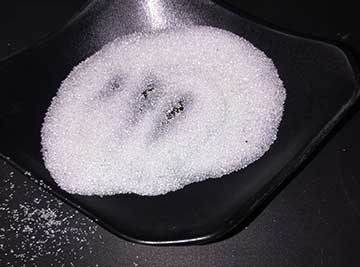1.0 Classification
1.1.1 Classification by Material system
I. Glass microspheres derived from silica: These chemically inert microspheres, which are mostly made of silica, are frequently added to paints and coatings and utilized in environmental sensing and monitoring.
II. Borosilicate glass microspheres: These glass compositions have sufficient thermal stability, which qualifies them for high-temperature uses such thermal insulators and catalyst supports.
III. Glass microspheres with calcium phosphate: They belong to a distinct class of microspheres where phosphate and calcium ions make up the majority of their makeup. These microspheres’ biocompatibility, bioactivity, and diverse qualities make them highly interesting for a range of biomedical and materials science applications.
IV. Composite glass microspheres: Certain qualities, including electrical conductivity or magnetic responsiveness, can be improved by adding other elements, such as metals or polymers, to the glass matrix.
1.1.2 Classification by Enivrnmental Fields
I. Environmental Remediation: To enable safe disposal of hazardous waste items, glass microspheres are employed to encapsulate and immobilize them.
II. Water Treatment: By eliminating pollutants and particle debris, they are used as filter medium to improve the quality of water.
III. Energy Efficiency: HGMs are low-weight fillers that improve insulation and lower energy usage in construction materials.
1.1.3 Grouping based on Primary Performance Elements
I. Buoyancy: HGMs’ low density makes them perfect for uses where buoyancy is needed.
II. Mechanical strength: Glass microspheres’ innate strength enables them to endure adverse climatic conditions and be used as building materials and road enhancement materials.
III. Chemical inertness: Glass microspheres can be used in hydrogen storage since they are resistant to chemical deterioration and corrosion.
IV. Thermal stability: Borosilicate glass microspheres are suited for high- temperature applications because to their exceptional thermal resilience.
1.2 Types of Glass Microspheres
1.2.1 Solid Glass Microspheres
Higher pressures may be tolerated by thick, strong, and solid glass microspheres. They are constructed from many glass varieties, each with unique benefits, including lead, borosilicate, and soda-lime glass. Lead glass microspheres, for example, are frequently used due to their high refractive index, which is advantageous in applications requiring optical qualities. Solid glass microspheres are utilized in situations where strength and structural integrity are essential, such as in brachytherapy, a medical procedure where the microspheres can be radiolabeled and used to selectively irradiate malignancies.
1.2.2 Hollow Glass Microspheres
The superior thermal insulation qualities and low density of hollow glass microspheres define them. They are lightweight due to their hollow structure, which helps reduce the weight of composite materials. These microspheres are utilized to produce lightweight materials without sacrificing strength in a number of sectors, including aerospace, automotive, and construction.
There are several ways to make hollow glass microspheres, including using rice husk ash, which provides a sustainable substitute for making glass microspheres for uses like road marking. Additionally, they are employed in the creation of lightweight cementitious composites, which may have better thermal and mechanical insulation qualities. Furthermore, because of their bioactive qualities, hollow glass microspheres can be employed in biological applications like the fabrication of 3D bone tissue.
Reference:
- J.-L. Hu, et al., Silica-based hybrid microspheres: synthesis, characterization and wastewater treatment, RSC Adv. 3 (48) (2013), 25620, https://doi.org/10.1039/ c3ra44111c.
- M. Mahmoud, et al., Porous glass microspheres from alkali-activated fiber glass waste, Materials 15 (3) (2022) 1043, https://doi.org/10.3390/ma15031043.
- K.M.Z. Hossain, et al., Porous calcium phosphate glass microspheres for orthobiologic applications, Acta Biomater. 72 (2018) 396–406, https://doi.org/ 10.1016/j.actbio.2018.03.040
- A. Vignali, et al., Lightweight poly(epsilon-caprolactone) composites with surface modified hollow glass microspheres for use in rotational molding: thermal, rheological and mechanical properties, Polymers 11 (4) (2019), https://doi.org/ 10.3390/polym11040624.
- A. Belostozky, et al., Solidification of oil liquids by encapsulation within porous hollow silica microspheres of narrow size distribution for pharmaceutical and cosmetic applications, Mater. Sci. Eng., C 97 (2019) 760– 767, https://doi.org/ 10.1016/j.msec.2018.12.093.
- S.A. Samad, et al., Upcycling glass waste into porous microspheres for wastewater treatment applications: efficacy of dye removal, Materials 15 (17) (2022), https://doi.org/10.3390/ma15175809.
- F. Aslani, L. Wang, Development of strain-hardening lightweight engineered cementitious composites using hollow glass microspheres, Struct. Concr. 21 (2) (2019) 673–688, https://doi.org/10.1002/suco.201900096.
- B. Zheng, et al., Buoyancy materials of aluminium borosilicate glass for high temperature resistance, Mater. Res. Innovat. 19 (sup4) (2015) S50–S53, https:// doi.org/10.1179/1432891715z.0000000001515.
- C. Feng, et al., The effects of hollow glass microsphere modification on the road performances and thermal performance of asphalt binder and mixture, Construct. Build. Mater. 220 (2019) 64–75, https://doi.org/10.1016/j. conbuildmat.2019.05.183
- S. Dalai, V. Savithri, P. Sharma, Investigating the effect of cobalt loading on thermal conductivity and hydrogen storage capacity of hollow glass microspheres (HGMs), Mater. Today: Proc. 4 (11) (2017) 11608–11616, https://doi.org/ 10.1016/j.matpr.2017.09.072.
- G.C. Righini, Glassy microspheres for energy applications, Micromachines 9 (8) (2018), https://doi.org/10.3390/mi9080379.
- Budov, V.V. (1991). Strength of different types of hollow glass microspheres. Strength of Materials, 23, 569-571.
- Pase Neto, J., Teixeira, I., Armas, L.E., Valsecchi, C., & Menezes, J.W. (2023). Road Marking Glass Microspheres Fabricated from Rice Husk Ash. Materials Research.
- Kabay, N., Kizilkanat, A.B., Akturk, B., & Kahraman, Y. (2020). Lightweight Cement-Based Composites Incorporating Hollow Glass Microspheres: Fresh and Hardened State Properties. Teknik Dergi.

